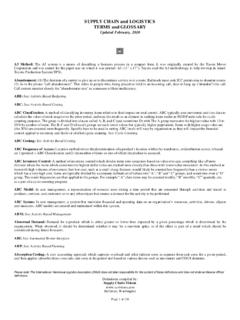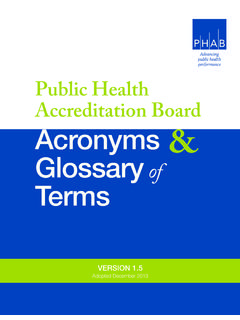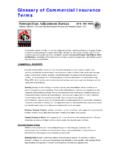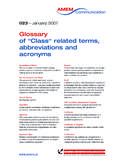Transcription of PMBOK GLOSSARY - Project Management Courses …
1 Copyright: Prof. A. Jaafari (2003). All rights reserved page 187 PMBOK GLOSSARY Accountability Matrix. See responsibility assignment matrix. Activity. An element of work performed during the course of a Project . An activity normally has an expected duration, an expected cost, and expected resource requirements. Activities are often subdivided into tasks. Activity Definition. Identifying the specific activities that must be performed in order to produce the various Project deliverables. Activity Description (AD). A short phrase or label used in a Project network diagram. The activity description normally describes the scope of work of the activity. Activity Duration Estimating. Estimating the number of work periods which will be needed to complete individual activities.
2 Activity-On-Arrow (AOA). See arrow diagramming method. Activity-On-Node (AON). See precedence diagramming method. Actual Cost of Work Performed (ACWP). Total costs incurred (direct and indirect) in accomplishing work during a given time period. See also earned value. Actual Finish Date (AF). The point in time that work actually ended on an activity. (Note: in some application areas, the activity is considered "finished" when work is "substantially complete.") Actual Start Date (As). The point in time that work actually started on an activity. Administrative Closure. Generating, gathering, and disseminating information to formalize Project completion. Application Area. A category of projects that have common elements not present in all projects. Application areas are usually defined in terms of either the product of the Project ( , by similar technologies or industry sectors) or the type of customer ( , internal vs.)
3 External, government vs. commercial). Application areas often overlap. Arrow. The graphic presentation of an activity. See also arrow diagramming method. Arrow Diagramming Method (ADM). A network diagramming technique in which activities are represented by arrows. The tail of the arrow represents the start and the head represents the finish of the activity (the length of the arrow does not represent the expected duration of the activity). Activities are connected at points called nodes (usually drawn as small circles) to illustrate the sequence in which the activities are expected to be performed. See also precedence diagramming method. As-of Date. See data date. Backward Pass. The calculation of late finish dates and late start dates for the uncompleted portions of all network activities. Determined by working backwards through the network logic from the Project 's end date.
4 The end date may be calculated in a forward pass or set by the customer or sponsor. See also network analysis. Copyright: Prof. A. Jaafari (2003). All rights reserved page 188 Bar Chart. A graphic display of schedule-related information. In the typical bar chart, activities or other Project elements are listed down the left side of the chart, dates are shown across the top, and activity durations are shown as date-placed horizontal bars. Also called a Gantt chart. Baseline. The original plan (for a Project , a work package, or an activity), plus or minus approved changes. Usually used with a modifier ( , cost baseline, schedule baseline, performance measurement baseline). Baseline Finish Date. See scheduled finish date. Baseline Start Date.
5 See scheduled start date. Budget At Completion (BAC). The estimated total cost of the Project when done. Budget Estimate. See estimate. Budgeted Cost of Work Performed (BCWP). The sum of the approved cost estimates (including any overhead allocation) for activities (or portions of activities) completed during a given period (usually Project -to-date). See also earned value. Budgeted Cost of Work Scheduled (BCWS). The sum of the approved cost estimates (including any overhead allocation) for activities (or portions of activities) scheduled to be performed during a given period (usually Project -to-date). See also earned value. Calendar unit. The smallest unit of time used in scheduling the Project . Calendar units are generally in hours, days, or weeks, but can also be in shifts or even in minutes.
6 Used primarily in relation to Project Management software. Change Control Board (CCB). A formally constituted group of stakeholders responsible for approving or rejecting changes to the Project baselines. Change in Scope. See scope change. Chart of Accounts. Any numbering system used to monitor Project costs by category ( , labor, supplies, materials). The Project chart of accounts is usually based upon the corporate chart of accounts of the primary performing organization. See also code of accounts. Charter. See Project charter. Code of Accounts. Any numbering system used to uniquely identify each element of the work breakdown structure. See also chart of accounts. Communications Planning. Determining the information and communications needs of the Project stakeholders. Concurrent Engineering.
7 An approach to Project staffing that, in its most general form, calls for implementors to be involved in the design phase. Sometimes confused with fast tracking. Contingencies. See reserve and contingency planning. Contingency Allowance. See reserve. Contingency Planning. The development of a Management plan that identifies alternative strategies to be used to ensure Project success if specified risk events occur. Contingency Reserve. A separately planned quantity used to allow for future situations which may be planned for only in part (sometimes called "known unknowns"). For example, rework is certain, the amount of rework is not. Contingency reserves may involve cost, schedule, or both. Contingency reserves Copyright: Prof. A. Jaafari (2003). All rights reserved page 189are intended to reduce the impact of missing cost or schedule objectives.
8 Contingency reserves are normally included in the Project 's cost and schedule baselines. Contract. A contract is a mutually binding agreement which obligates the seller to provide the specified product and obligates the buyer to pay for it. Contracts generally fall into one of three broad categories: ??Fixed price or lump sum contracts--this category of contract involves a fixed total price for a well-defined product. Fixed price contracts may also include incentives for meeting or exceeding selected Project objectives such as schedule targets. ??Cost reimbursable contracts--this category of contract involves payment (reimbursement) to the contractor for its actual costs. Costs are usually classified as direct costs (costs incurred directly by the Project , such as wages for members of the Project team) and indirect costs (costs allocated to the Project by the performing organization as a cost of doing business, such as salaries for corporate executives).
9 Indirect costs are usually calculated as a percentage of direct costs. Cost reimbursable contracts often include incentives for meeting or exceeding selected Project objectives such as schedule targets or total cost. ??Unit price contracts--the contractor is paid a preset amount per unit of service ( , $70 per hour for professional services or $ per cubic yard of earth removed) and the total value of the contract is a function of the quantities needed to complete the work. Contract Administration. Managing the relationship with the seller. Contract Close-out. Completion and settlement of the contract, including resolution of all outstanding items. Control. The process of comparing actual performance with planned performance, analyzing variances, evaluating possible alternatives, and taking appropriate corrective action as needed.
10 Control Charts. Control charts are a graphic display of the results, over time and against established control limits, of a process. They are used to determine if the process is "in control" or in need of adjustment. Corrective Action. Changes made to bring expected future performance of the Project into line with the plan. Cost Budgeting. Allocating the cost estimates to individual Project components. Cost Control. Controlling changes to the Project budget. Cost Estimating. Estimating the cost of the resources needed to complete Project activities. Cost of Quality. The costs incurred to ensure quality. The cost of quality includes quality planning, quality control, quality assurance, and rework. Cost Performance Index (CPI). The ratio of budgeted costs to actual costs (BCWP/ACWP).








